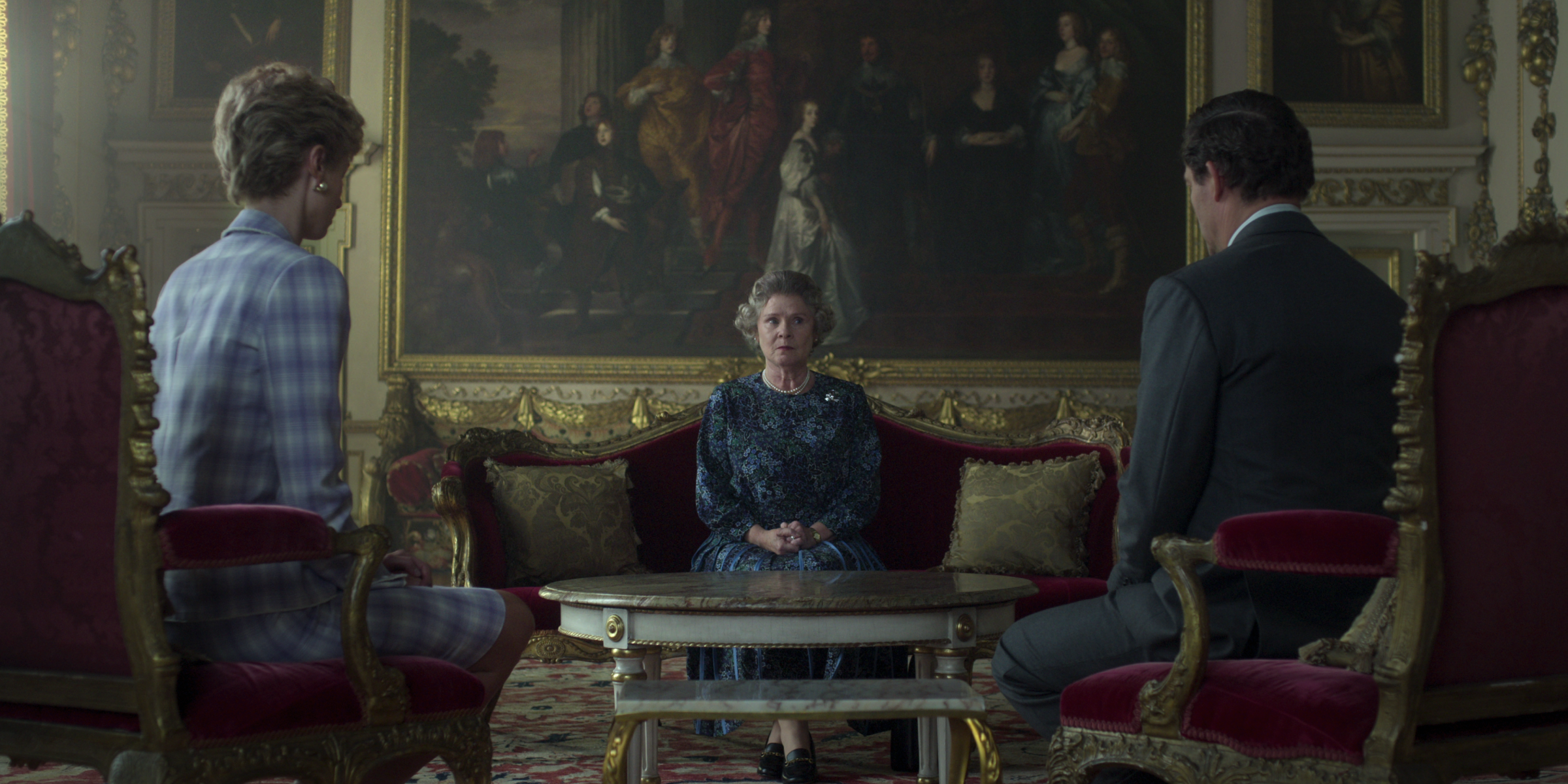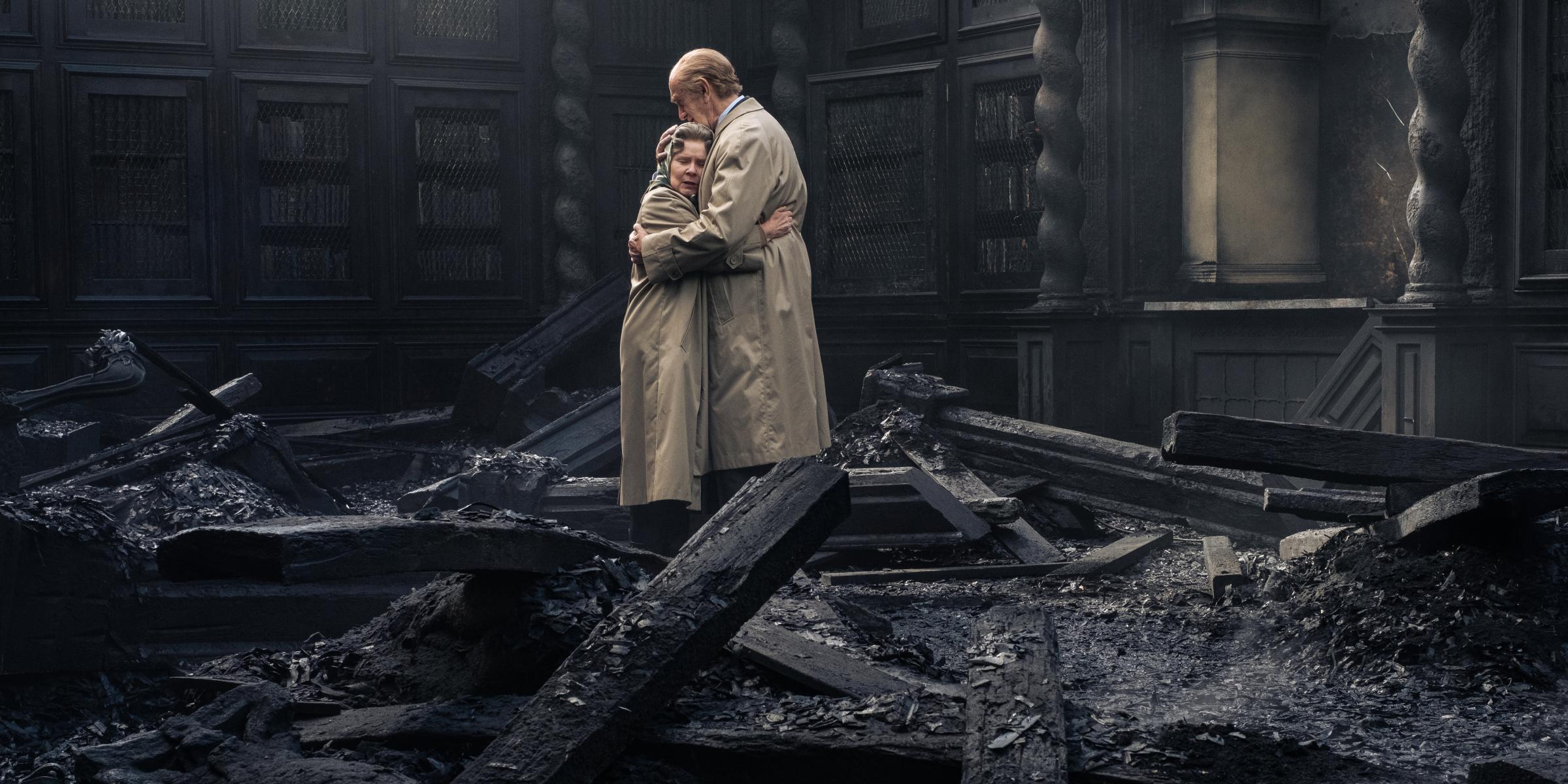Warning: This post contains spoilers for The Crown.
Queen Elizabeth II marked the 40th year of her reign with a surprisingly vulnerable speech. The usually taciturn and steady monarch stood up in front of 500 guests at a Corporation of London Guildhall luncheon on Nov. 24, 1992 to declare the past year the lowest point of her tenure.
“1992 is not a year on which I shall look back with undiluted pleasure,” she said. “In the words of one of my more sympathetic correspondents, it has turned out to be an ‘Annus Horribilis’.” It was a plea that the New York Times called “about the only public utterance that ever betrayed any inner turmoil.”
It was, indeed, a horrible year. Queen Elizabeth II suffered through a series of disasters both personal and symbolic: Three of her children separated from their spouses; the family was plagued by scandal in the tabloids; and her beloved childhood home caught fire. The scandals and mishaps shattered the royal myth. Just four days after the fire, she gave what would come to be known as the annus horribilis speech.
In her remarks, Elizabeth asked for empathy from her subjects as she struggled through a difficult time. “No institution, city, monarchy, whatever, should expect to be free from the scrutiny of those who give it their loyalty and support, not to mention those who don’t,” she said. “But we are all part of the same fabric of our national society and that scrutiny, by one part of another, can be just as effective if it is made with a touch of gentleness, good humor, and understanding.” She received a standing ovation.
Here’s everything that happened in that difficult year that brought even the most stoic monarch nearly to tears.
Read More: As King Charles III Sets Out to Win Hearts and Minds, The Crown Dredges Up His Darkest Chapter
Three of the queen’s children separated in the same year

Royal marriages suffered quite the blow in 1992. Three of the queen’s four children separated from their partners in a single year.
In March, Prince Andrew separated from Sarah Ferguson. In April, Princess Anne divorced her husband of 18 years, Mark Phillips. And though the official announcement was not made until Dec. 9, after the annus horribilis speech, Prince Charles, the heir to the throne, separated from Princess Diana.
In his book Queen of Our Times: The Life of Queen Elizabeth II, author Robert Hardman writes that the Queen took each breakup as a personal blow. “Outwardly stoical, as ever, the Queen was finding the divorce talks deeply upsetting,” Hardman writes. “Another former member of the Household recalls that, every now and then, there would be a glimpse of her despair.”
“It distressed her much more than she let on,” a former staffer told Hardman. “I said, ‘Ma’am, it seems to be happening everywhere. This is almost common practice.’ But she just said, ‘Three out of four!’ in sheer sadness and exasperation. One shouldn’t underestimate the pain she’s been through.”
Read More: How A Sprawling Drama About Elizabeth II Became Netflix’s Crown Jewel
The Diana biography

The various separations and divorces were preceded by seedy tabloid stories that dragged the royal family through the mud. Andrew Morton’s biography Diana: Her True Story made headlines when it was published in 1992 for its revelations that Charles had been cheating on Diana with Camilla Parker Bowles and that Diana had struggled with mental health issues and disordered eating.
At the time, Diana denied cooperating with Morton on the book. Only after her death did Morton reveal that the princess had supplied him with tape recordings detailing her struggles. The book seemed to break a dam in the royal public discourse. Of course the perfection of the royal family was a facade—there were surely many unhappy marriages preceding those of three of Elizabeth’s four children. But the family kept up appearances, and the public seemed happy, for the most part, to buy into the illusion.
The exposure of Charles’ infidelity, and descriptions of emotional cruelty at the hands of royal family members, rendered the lofty beings in the palace knowable and thus open to critique. In her biography of Diana, The Diana Chronicles, Tina Brown marks the publication of Morton’s book as a turning point for the royal family. Never again would they seem untouchable.
“The storm, when it broke, did more than make the teacups dance. It blew through the House of Windsor and every assumption of Establishment consensus—discretion, deference, and mutual protection. Its assertion was that Diana wouldn’t settle for the system of structural infidelity that maintained royal marital facades of the past,” Brown writes. “If the royal family was as imperfect as every other family in the kingdom, it might as well be treated as such—an idea that had implications beyond the soap opera of the moment.”
Read More: Why Princess Diana Is So Hard to Get Right Onscreen
Tampongate, Squidgygate, and Sarah Ferguson’s photos

In August of 1992, The Enquirer published the transcript of a private phone conversation between Princess Di and her friend James Gibley, which took place on New Year’s Eve 1989. Gilbey referred to Diana multiple times by the nickname “squidgey,” suggesting an intimacy to the call. Diana complained on the phone about “all [she’d] done for this f—ing family.”
That same month, the Queen’s newly-separated daughter-in-law Sarah Ferguson appeared in tabloid photos topless having her feet kissed by American businessman John Bryan.
But both of those incidents would quickly be overshadowed by “Tampongate.” In a very intimate 1989 conversation, Charles told Camilla over the phone that he wished he could live “inside her trousers.” When she teased him that he would be reincarnated as “knickers,” he joked that it would be just his luck to return as a tampon instead. The conversation was recorded by an amateur radio enthusiast and sold to the tabloids. First teased in the papers in the fall of 1992 and published in full in January of 1993, “Tampongate” seemed to not only confirm Charles and Camilla’s affair but undercut Charles’ authority as the future king.
Read More: The 7 Best Movies and TV Shows to Watch About Princess Diana
The Windsor Castle Fire

On Nov. 20, 1992, a fire broke out at Windsor Castle and burned for 15 hours. A royal residence first built by William the Conquerer in 1070, Windsor Castle was home to the Queen during World War II. The royal family had had the option to evacuate to Canada during the war, but refused to abandon England.
Elizabeth was personally devastated by the destruction of her childhood home. The blaze burned for 15 hours and destroyed nine apartments and an additional 100 rooms, though many priceless works of art were saved by the staff. Nor was the symbolism lost on the media.
“The graphic destruction of the ancient stronghold after which the dynasty was named reverberated eerily with the catalogue of royal disasters of the previous months,” writes Robert Lacey in his biography Monarch: The Life and Reign of Elizabeth II.
The fire caused $47.5 million in damage, and royalists clashed with the public over who would foot the bill for repairs. The crown, not the monarch, owns Windsor Castle, and when Prime Minister John Major suggested the public could pay to restore the castle, he was met with an outcry. “The immediate response was outrage—a popular revolt of astonishing unanimity and power,” writes Lacey. “While people might feel sorry for the queen as a person, the misadventures of her children in the previous months had left even her most loyal supporters embarrassed and angry.”
To fund repairs, Queen Elizabeth II opened parts of Buckingham Palace to the public for the first time. She also volunteered to start paying income tax for the first time in her reign.
More Must-Reads from TIME
- Cybersecurity Experts Are Sounding the Alarm on DOGE
- Meet the 2025 Women of the Year
- The Harsh Truth About Disability Inclusion
- Why Do More Young Adults Have Cancer?
- Colman Domingo Leads With Radical Love
- How to Get Better at Doing Things Alone
- Michelle Zauner Stares Down the Darkness
Write to Eliana Dockterman at eliana.dockterman@time.com